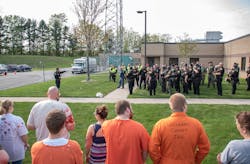Active Shooter Command Training & Protocol Review Responsibility
Tactics develop
Back in 2000, the originally developed (new at the time) active shooter response protocols called for a four-man team to make entry in a diamond formation, move to the sound of shots and neutralize whatever threat they found. Through the early years of response evolution, that number dropped to two officers and then again to a single officer. The reality is, if we’re going to accept the risk of entering a high threat zone so that we can mitigate the threat to students, why should we wait for sufficient numbers to reduce our own risk? Is that perceived threat reduction real? Or are we simply delaying action? Although a final answer was never developed, the reality was recognized—we’re accepting risk. Get there, go in. Don’t wait. Don’t delay.
We’ve learned other lessons through the years: breaching tools may be needed; rifles are a good option because of long hallways, but not mandatory; and improvised explosives are a possibility as a secondary weapon of the attacker(s).
We will also likely spend more time providing security and trauma care/support for EMS than we do in the initial response/neutralization of the threat. In many urban areas, manpower for response won’t be a large issue; rather, managing the number of responders, victims, witnesses, multiple scenes and more will present greater challenges.
With all of that in mind, it is the responsibility of any law enforcement command/executive officer to review the agency response policies, operational protocols, issued equipment and training delivered to ensure that contemporary best practices are being trained and supported and therefore put into use. Keeping that in mind, start at your high core agency culture and work your way down the chain and out into the community evaluating everything involved in an active shooter response and update as you find deficiencies (if any). It’s important to note that just because no deficiencies are found this month or this year, doesn’t mean you’re 100 percent up to date three months from now. It’s recommended that you have an officer or two (every agency has at least one) who pays attention to active shooter events, studies them, evaluates the reported response, looks for holes or performance challenges and makes recommendations up the chain of command to ensure lessons learned are incorporated and enacted.Start at the high core of your own agency:
- What is your chief executive/administrative officer’s outlook towards training and protocols? We’re talking about the Sheriff, Chief of Police or other senior-most officer on the agency. Is that person thinking, “It can’t happen here” or more correctly, “We’d better be as ready as possible should it ever happen here”? The first thought is a mistake. It can happen anywhere.
- Does the agency policy, applicable General Order or Standard Operating Procedure properly dictate and give guidance for expected response? If not, why not? Yes, it’s a pain to rewrite any of those items. It’s a larger pain to get the governmental body involved to “sign off on it.” It’s worth it though. The last thing any commander wants is to think, “I was just looking at this two months ago and saw that problem. We should have dealt with it then.”
- Does the agency’s list of issued equipment include the necessary or approved tools for a proper response? Such tools should include adequate weapons and ammunition, potential breaching tools, trauma and first aid supplies, upgraded body armor and more. The “more” is controlled by what your agency can afford in its budget and what it can train each officer with included in that budget.
- Does the training being delivered reflect the agency’s current policy, protocol and best practices? This means not just training for arrival, entry, movement and neutralization. It means training every level of operation from patrol response to first line supervision to command management. It means training for evacuations, security, multiple scene control, necessary briefings, standing area planning, and parent/student reunification rally points. It means a community communication plan and media management protocols. It means allied agency coordination plans and cross-training with members of those allied agencies.
Proper planning, evaluation, review, updates and training encompasses far more than looking at patrol response training curriculum and signing off on it simply because you have one that looks good. It requires regular reviews and updates incorporating lessons learned. It will also require adjustments to training and equipment budgets.
This article is part of a series of articles dedicated to responding to and prevention of active shooter events. Download and share the entire series here.




